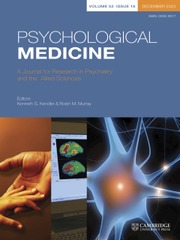Impact of early adversity and adult emotional distress on immune function
The cross-sectional design employed in this study limits definitive interpretation of the causal relationship and temporal development between early adversity and adult emotional distress (Michal, Marquardt, Krueger, Arbisi, & Venables, Reference Michal, Marquardt, Krueger, Arbisi and Venables2025). Specifically, to comprehensively examine the effects of early adversity and adult emotional distress on inflammation, a comparative analysis of four distinct groups would be more informative: (i) no early adversity and no adult emotional distress, (ii) no early adversity but with adult emotional distress, (iii) early adversity but no adult emotional distress, and (iv) both early adversity and adult emotional distress. The present study’s conclusions are drawn primarily from analysis of group (iv) alone, which represents a methodological limitation. Unfortunately, the current sample size and research design make it difficult to substantiate the potential amplifying effect of early adversity on midlife immune changes (Baumeister, Akhtar, Ciufolini, Pariante, & Mondelli, Reference Baumeister, Akhtar, Ciufolini, Pariante and Mondelli2015; Elwenspoek et al., Reference Elwenspoek, Hengesch, Schaan, Schmitter, Turner, Müller and Bonnemberger2017). Longitudinal verification through prospective studies is necessary to address this limitation (Baumeister et al., Reference Baumeister, Akhtar, Ciufolini, Pariante and Mondelli2015; Elwenspoek et al., Reference Elwenspoek, Hengesch, Schaan, Schmitter, Turner, Müller and Bonnemberger2017).
Factors influencing adult emotional distress
Beyond early adversity, several other factors contribute to adult emotional distress, including family environment, workplace conditions, genetic predisposition, and social determinants (Brandt, Liu, Heim, Binder, & Belsky, Reference Brandt, Liu, Heim, Binder and Belsky2022; Hamouche, Reference Hamouche2020; Knyazev, Bocharov, Savostyanov, & Proshina, Reference Knyazev, Bocharov, Savostyanov and Proshina2023; Yuan, Zhang, Zhou, & Zhou, Reference Yuan, Zhang, Zhou and Zhou2021). It is essential to adjust for these confounding variables before discussing potential relationships between the primary variables of interest.
Based on these considerations, we respectfully request that the authors address the following points:
Conduct comparative analyses across all four groups (i–iv) to clearly demonstrate the contribution of each factor and their synergistic effects. This would add greater reliability to the examination of causal relationships, providing more robust conclusions than those derived from focusing solely on group (iv).
Either include the four aforementioned confounding factors as covariates or perform appropriate stratified or sensitivity analyses to more rigorously evaluate the influence of the primary independent variables: early adversity and adult emotional distress.
We appreciate your attention to these considerations and look forward to the authors’ response.
We read with great interest the articles by Zachary S. Michal, Paul A. Arbisi, Craig A. Marquardt, and Noah C. Venables titled “Early adversity and inflammation at midlife: the moderating role of internalizing psychopathology” (Psychological Medicine 54, 4518–4527). This study makes a valuable contribution by elucidating how internalizing psychopathology moderates the impact of early adversity on adult inflammation, thereby deepening our understanding of the interrelationship between mental and physical health. However, we would like to highlight several limitations and challenges that warrant further consideration.
Acknowledgments
The authors would like to acknowledge the use of an AI language model (Claude, Anthropic) for English language editing assistance. The authors are entirely responsible for the content of the manuscript.
Author contribution
H.T. wrote the draft. M.K. and T.A. revised and approved the final version. The authors have read and approved the final manuscript.
Funding statement
This study received no funding.
Competing interests
The authors declare none.


